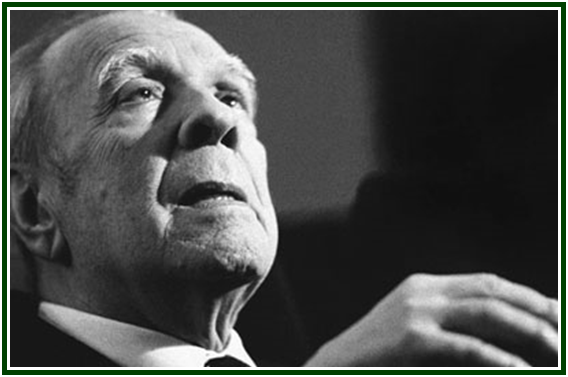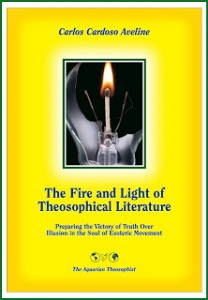
Examining an Infinite Sphere, the Center of
Which is Everywhere, and the Circumference Nowhere
Jorge Luis Borges

Jorge Luis Borges (1899-1986)
A 2012 Editorial Note:
In her classical work “The Secret Doctrine”, Helena Blavatsky wrote:
“… The primordial form of everything manifested, from atom to globe, from man to angel, is spheroidal, the sphere having been with all nations the emblem of eternity and infinity – a serpent swallowing its tail. To realize the meaning, however, the sphere must be thought of as seen from its centre. The field of vision or of thought is like a sphere whose radii proceed from one’s self in every direction, and extend out into space, opening up boundless vistas all around. It is the symbolical circle of Pascal and the Kabalists, ‘whose centre is everywhere and circumference nowhere’ (…)”. (“The Secret Doctrine”, Helena P. Blavatsky, Theosophy Company, Los Angeles, volume I, p. 65.)
The Russian thinker also said:
“…The definition of Deity by the Circle is not Pascal’s at all, as E. Levi thought. It was borrowed by the French philosopher from either Mercury Trismegistus or Cardinal Cusa’s Latin work, De Docta Ignorantia, in which he makes use of it. It is, moreover, disfigured by Pascal, who replaces the words ‘Cosmic Circle’, which stand symbolically in the original inscription, by the word Theos. With the ancients both words were synonymous.” (“The Secret Doctrine”, volume II, p. 545.)
In the following text, Jorge Luis Borges shares the same viewpoint adopted by H. P. Blavatsky.
He practices contemplation of universal truths while examining philosophical aspects of human history. Writing to the great public with a high degree of bibliographical erudition, Borges hides his esoteric philosophy in humour and irony. [1]
We have added the subtitle.
(Carlos Cardoso Aveline)
Pascal’s Sphere
Jorge Luis Borges
Perhaps universal history is the history of a few metaphors. I should like to sketch one chapter of that history.
Six centuries before the Christian era Xenophanes of Colophon, the rhapsodist, weary of the Homeric verses he recited from city to city, attacked the poets who attributed anthropomorphic traits do the gods; the substitute he proposed to the Greeks was a single God: an eternal sphere. In Plato’s Timaeus we read that the sphere is the most perfect and most uniform shape, because all points in its surface are equidistant from the center. Olof Gigon (Ursprung der griechischen Philosophie, 183) says that Xenophanes shared that belief; the God was spheroid, because that form was the best, or the least bad, to serve as a representation of the divinity. Forty years later, Parmenides of Elea repeated the image (“Being is like the mass of a well-rounded sphere, whose force is constant from the center in any direction”). Calogero and Mondolfo believe that he envisioned an infinite, or infinitely growing sphere, and that those words have a dynamic meaning (Albertelli, Gli Eleati, 148). Parmenides taught in Italy; a few years after he died, the Sicilian Empedocles of Agrigentum plotted a laborious cosmogony, in one section of which the particles of earth, air, fire, and water compose an endless sphere, “the round Sphairos, which rejoices in its circular solitude.”
Universal history followed its course. The too-human gods attacked by Xenophanes were reduced to poetic fictions or to demons, but it was said that one god, Hermes Trismegistus, had dictated a variously estimated number of books (42, according to Clement of Alexandria; 20,000, according to Iamblichus; 36,525, according to the priests of Thoth, who is also Hermes), on whose pages all things were written. Fragments of that illusory library, compiled or forged since the third century, form the so-called Hermetica. In one part of the Asclepius, which was also attributed to Trismegistus, the twelfth-century French theologian, Alain de Lille – Alanus de Insulis – discovered this formula, which future generations would not forget: “God is an intelligible sphere, whose center is everywhere and whose circumference is nowhere.” The Pre-Socratic spoke of an endless sphere; Albertelli (like Aristotle before him) thinks that such a statement is a contradictio in adjecto, because the subject and predicate negate each other. Possibly so, but the formula of the Hermetic books almost enables us to envisage that sphere. In the thirteenth century the image reappeared in the symbolic Roman de la Rose, which attributed it to Plato, and in the Speculum Triplex encyclopedia. In the sixteenth century the last chapter of the last book of Pantagruel referred to “that intellectual sphere, whose center is everywhere and whose circumference nowhere, which we call God.” For the medieval mind, the meaning was clear: God is in each one of his creatures, but it not limited by anyone of them. “Behold, the heaven and heaven of heavens cannot contain thee,” said Solomon (I Kings 8:27). The geometrical metaphor of the sphere must have seemed like a gloss of those words.
Dante’s poem has preserved Ptolemaic astronomy, which ruled men’s imaginations for fourteen hundred years. The earth is the center of the universe. It is an immovable sphere, around which nine concentric spheres revolve. The first seven are the planetary heavens (the heavens of the Moon, Mercury, Venus, the Sun, Mars, Jupiter, and Saturn); the eighth, the Heaven of Fixed Stars; the ninth, the Crystalline Heaven (called the Primum Mobile), surrounded by the Empyrean, which is made of light. That whole laborious array of hollow, transparent, and revolving spheres (one system required fifty-five) had come to a mental necessity. De hypothesibus motuum coelestium commentariolus was the timid title that Copernicus, the disputer of Aristotle, gave to the manuscript that transformed our vision of the cosmos. For one man, Giordano Bruno, the breaking of the sidereal vaults was a liberation. In La cena de le ceneri he proclaimed that the world was the infinite effect of an infinite cause and the divinity was near, “because it is in us even more than we ourselves are in us.” He searched for the words that would explain Copernican space to mankind, and on one famous page he wrote: “We can state with certainty that the universe is all center, or that the center of the universe is everywhere and the circumference nowhere” ( De la causa, principio e uno, V).
That was written exultantly in 1584, still in the light of the Renaissance; seventy years later not one spark of that fervor remained and men felt lost in time and space. In time, because if the future and the past are infinite, there will not really be a when; in space, because if every being is equidistant from the infinite and the infinitesimal, there will not be a where. No one exists on a certain day, in a certain place; no one knows the size of his face. In the Renaissance humanity thought it had reached adulthood, and it said as much through the mouths of Bruno, Campanella, and Bacon. In the seventeenth century humanity was intimidated by a feeling of old age; to vindicate itself it exhumed the belief of a slow and fatal degeneration of all creatures because of Adam’s sin. (In Genesis 5:27 we read that “all the days of Methuselah were nine hundred sixty and nine years”; in 6:4, that “There were giants in the earth in those days.”) The elegy Anatomy of the World, by John Donne, deplored the very brief lives and the slight stature of contemporary men, who could be likened to fairies and dwarfs. According to Johnson’s biography, Milton feared that an epic genre had become impossible on earth. Glanvill thought that Adam, God’s medal, enjoyed a telescopic and microscopic vision. Robert South wrote, in famous words, that an Aristotle was merely the wreckage of Adam, and Athens, the rudiments of Paradise. In that jaded century the absolute space that inspired the hexameters of Lucretius, the absolute space that had been a liberation for Bruno, was a labyrinth and an abyss for Pascal. He hated the universe, and yearned to adore God. But God was less real to him than the hated universe. He was sorry that the firmament could not speak; he compared our lives to those of shipwrecked men on a desert island. He felt the incessant weight of the physical world; he felt confused, afraid, and alone; and he expressed his feelings like this: “It [nature] is an infinite sphere, the center of which is everywhere, the circumference nowhere.” That is the text of the Brunschvicg edition, but the critical edition of Tourneur (Paris, 1941), which reproduces the cancellations and the hesitations of the manuscript, reveals that Pascal started to write effroyable: “A frightful sphere, the center of which is everywhere, and the circumference nowhere.”
Perhaps universal history is the history of the diverse intonation of a few metaphors.
Buenos Aires, 1951.
NOTE:
[1] The text “Pascal’s Sphere” is reproduced from the volume “Other Inquisitions, 1937-1952”, by Jorge Luis Borges, University of Texas Press, Translated from Spanish by Ruth L.C. Simms, 1993, 205 pp. Copyright English version, University of Texas Press. The subtitle – “Examining an Infinite Sphere, the Center of Which is Everywhere, and the Circumference Nowhere” – has been added by us. (CCA)
000
On the role of the esoteric movement in the ethical awakening of mankind during the 21st century, see the book “The Fire and Light of Theosophical Literature”, by Carlos Cardoso Aveline.

Published in 2013 by The Aquarian Theosophist, the volume has 255 pages and can be obtained through Amazon Books.
000